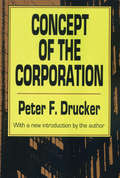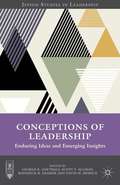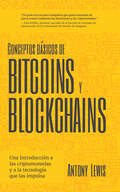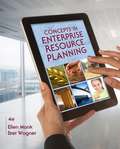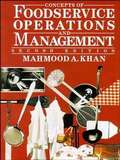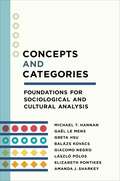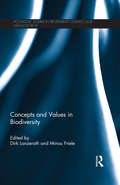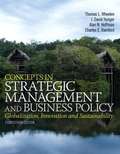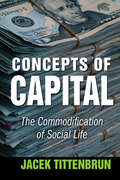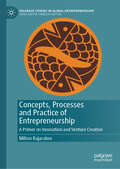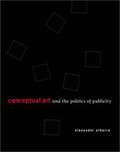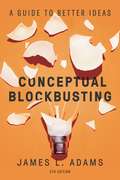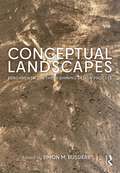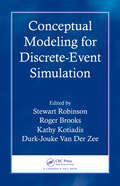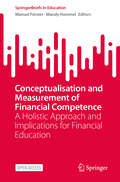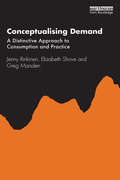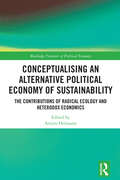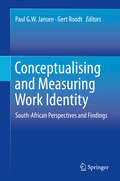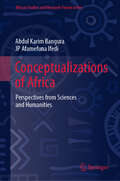- Table View
- List View
Concept Devices, Inc.: International Market Entry
by Thomas V. Bonoma Randy MaselConcept is a highly touted startup venture in distributed data processing computers. The company has only made one sale to date, but has an order backlog for its unique product and expects an almost vertical growth curve. The company has been courted seriously by potential partners in France and the United Kingdom. Management wishes to decide how best to set up distribution in Europe.
Concept Testing
by Robert J. DolanDescribes concept testing products. Presents guidelines for effective design, execution, and interpretation of test procedures. Discusses limitations of these techniques and sets out the situations for which they are appropriate.
Concept of the Corporation
by Peter DruckerConcept of the Corporation was the first study ever of the constitution, structure, and internal dynamics of a major business enterprise. Basing his work on a two-year analysis of the company done during the closing years of World War II, Drucker looks at the General Motors managerial organization from within. He tries to understand what makes the company work so effectively, what its core principles are, and how they contribute to its successes. The themes this volume addresses go far beyond the business corporation, into a consideration of the dynamics of the so-called corporate state itself.When the book initially appeared, General Motors managers rejected it as unfairly critical and antibusiness. Yet, the GM concept of the corporation and its principles of organization later became models for organizations worldwide. Not only businesses, but also government agencies, research laboratories, hospitals, and universities have found in Concept of the Corporation a basis for effective organization and management.Because it offers a fundamental theory of corporate goals, this book is a valuable resource for business professionals and organization analysts. It will also be of interest to students and professionals in economics, public administration, and political science. Professional and technical readers who admire Peter Drucker's work will want to be certain this volume is in their personal library. At a time when everything from the size to the structure of corporations is being questioned, this classic should prove a valuable guide.
Conceptions of Leadership
by Roderick M. Kramer George R. Goethals Scott T. Allison David M. MessickConceptions of Leadership gathers together the latest work by distinguished leadership scholars in social psychology and related disciplines to explore classic conceptions of leadership, such as interpersonal influence, charisma, personality, and power, as well as recent perspectives on those enduring concerns. It includes contemporary departures from traditional approaches to leadership in considering gender, trust, narratives, and the complex relationships between leaders and followers. Together the chapters provide a wide-ranging and coherent account of how human beings get along and the ways they engage and work together to accomplish their goals.
Conceptions of Professionalism: Meaningful Standards in Financial Planning
by Ken Bruce Abdullahi D. AhmedIn Conceptions of Professionalism, Ken Bruce and Abdullahi Ahmed present the results of research into understanding what professionalism means to individuals who are CERTIFIED FINANCIAL PLANNERâ„¢ professionals and how they conceive of acting professionally. Financial planning is establishing itself as a relatively new, emerging profession and an understanding of how its members experience professionalism provides insights that will help those responsible across the international financial planning community to establish relevant, accurate and meaningful professional standards for financial planners. The authors employ the relatively new research methodology of phenomenography, which enables them to describe the qualitatively different ways in which people understand or experience a phenomenon. This particularly lends itself to the study of a concept such as professionalism. This study gives voice to the financial planners represented in the research and will inform standard setting bodies seeking to understand professionalism through the eyes of the professionals themselves. What the research reveals about the concept of professionalism itself will be of value to those whose interests lie beyond the world of financial planning, and the application of the methodology used in the study will inform researchers contemplating phenomenographical studies elsewhere.
Conceptos básicos de Bitcoins y Blockchains: Una Introducción a las criptomonedas y a la tecnología que las impulsa
by Antony LewisAprende sobre invertir en Bitcoin, blockchains, y criptomonedas“Antony nos ayuda a entender claramente los mecanismos de bitcoins y blockchains.” —Rob Findlay, fundador de Next MoneyEl autor más vendido en inversión de derivados financieros, industria extractiva de recursos naturales, futuros, bancos y bancas, energía y minas, y política monetaria.Hay mucha información sobre criptomonedas y blockchains, pero para un principiante, esto puede ser indescifrable. Conceptos básicos sobre bitcoins y blockchains ofrece una guía clara sobre carteras digitales, esta nueva moneda y la tecnología revolucionaria que la impulsa.Bitcoin, Ethereum, Altcoin, criptografía y otras criptomonedas. Gana entendimiento de temas relacionados a Bitcoin, precio Bitcoin, moneda Bitcoin, minería Bitcoin, invertir en Bitcoin y los Bitcoins blockchains. Aprende cómo se realizan los pagos y cómo establecer el valor de las criptomonedas y de los tokens digitales.Aprende qué es blockchain. ¿Cómo funciona? ¿Y por qué es importante? Conceptos básicos sobre bitcoins y blockchains da respuestas a estas preguntas y más.Aprende sobre minería de criptomonedas y criptomonedas.Conceptos básicos sobre bitcoin y blockchains ofrece una perspectiva confiable de cómo invertir en Bitcoin y otras criptomonedas. Descubre los riesgos y las estrategias de mitigación, aprende cómo comprar Bitcoins, identificar estafas, y entender el cambio de criptomonedas, billeteras digitales, y regulaciones.Aprende sobre:Tecnología blockchain y a invertir en Bitcoin.Cómo trabajar en el mercado de las criptomonedas.La evolución y los impactos potenciales del Bitcoin y los blockchains a nivel mundial.Si has leído Descubre Blockchain, Blockchain Bubble or Revolution, Bitcoin Clarity, The Bitcoin Book, y Bitcoin and Cryptocurrency Trading for Beginners, entonces vas a aprender mucho con Conceptos básicos sobre bitcoins y blockchains.
Concepts In Enterprise Resource Planning, Fourth Edition
by Bret Wagner Ellen MonkLearn how to master and maximize enterprise resource planning (ERP) software -- which continues to grow in importance in business today -- with Monk/Wagner's CONCEPTS IN ENTERPRISE RESOURCE PLANNING, 4E. Readers discover how to use ERP tools to increase growth and productivity while reviewing how to effectively combine an organization's numerous functions into one comprehensive, integrated system. CONCEPTS IN ENTERPRISE RESOURCE PLANNING, 4E reflects the latest trends and updates in ERP software as well as introduces the basic functional areas of business and their relationships. Readers see how see how integrated information systems help organizations improve business process and provide managers with accurate, consistent, and current data for making informed strategic decisions.
Concepts Of Foodservice Operations And Management
by Mahmood KhanRevised and updated to highlight essential concepts in the operations and management of foodservice facilities, this edition outlines all steps in a simple and understandable fashion. The unique feature of the book continues to be the emphasis on systems, which applies to both commercial and institutional operations.
Concepts and Approaches for Sustainability Management (Advances in Science, Technology & Innovation)
by Khai Ern LeeWith the introduction of the 2030 Agenda for Sustainable Development by the United Nations General Assembly in 25 September 2015, UN agencies, member states and stakeholders have begun to focus on the adoption and implementation of these strategies in realization of 17 Sustainable Development Goals. To work toward sustainability, strategic measures to encourage stakeholders to contribute to the goals of the 2030 agenda are needed. In recognition of these efforts, this book is produced to compile research concepts and approaches for the area of sustainability management of industry, technology development, community, education and the environment. The objective of this book is to deliberate concepts and approaches of sustainability management taking place in Malaysia whereby case studies will be revealed to provide way forward of sustainability management toward achieving sustainable development. The insights provided can be applied to advanced and developing countries by sustainable development practitioners, encompassing government agencies, academia, industries, NGOs and community, who would like to adopt the concept of approach of sustainability into their area of management.
Concepts and Categories: Foundations for Sociological and Cultural Analysis (The Middle Range Series)
by Michael T. Hannan László Pólos Greta Hsu Giacomo Negro Gaël Le Mens Balázs Kovács Elizabeth Pontikes Amanda J. SharkeyWhy do people like books, music, or movies that adhere consistently to genre conventions? Why is it hard for politicians to take positions that cross ideological boundaries? Why do we have dramatically different expectations of companies that are categorized as social media platforms as opposed to news media sites? The answers to these questions require an understanding of how people use basic concepts in their everyday lives to give meaning to objects, other people, and social situations and actions.In this book, a team of sociologists presents a groundbreaking model of concepts and categorization that can guide sociological and cultural analysis of a wide variety of social situations. Drawing on research in various fields, including cognitive science, computational linguistics, and psychology, the book develops an innovative view of concepts. It argues that concepts have meanings that are probabilistic rather than sharp, occupying fuzzy, overlapping positions in a “conceptual space.” Measurements of distances in this space reveal our mental representations of categories. Using this model, important yet commonplace phenomena such as our routine buying decisions can be quantified in terms of the cognitive distance between concepts. Concepts and Categories provides an essential set of formal theoretical tools and illustrates their application using an eclectic set of methodologies, from micro-level controlled experiments to macro-level language processing. It illuminates how explicit attention to concepts and categories can give us a new understanding of everyday situations and interactions.
Concepts and Values in Biodiversity (Routledge Studies in Biodiversity Politics and Management)
by Dirk Lanzerath Minou FrieleBiodiversity may refer to the diversity of genes, species or ecosystems in general. These varying concepts of biodiversity occasionally lead to conflicts among researchers and policy makers, as each of them require a customized type of protection strategy. This book addresses the questions surrounding the merits of conserving an existing situation, evolutionary development or the intentional substitution of one genome, species or ecosystem for another. Any practical steps towards the protection of biodiversity demand a definition of that which is to be protected and, in turn, the motivations for protecting biodiversity. Is biodiversity a necessary model which is also useful, or does it carry intrinsic value? Debates like this are particularly complex when interested parties address it from different conceptual and moral perspectives. Comprised of three parts, each complemented by a short introductory paragraph, this collection presents a variety of approaches to this challenge. The chapters cover the perspectives of environmental scientists with expertise in evolutionary, environmental biology, systematic zoology and botany, as well as those of researchers with expertise in philosophy, ethics, politics, law and economics. This combination facilitates a truly interdisciplinary debate by highlighting hitherto unacknowledged implications that inform current academic and political debates on biodiversity and its protection. The book should be of interest to students and researchers of environment studies, biodiversity, environmental philosophy, ethics and management.
Concepts in Strategic Management and Business Policy: Globalization, Innovation and Sustainability
by Thomas L. Wheelen J. David Hunger Alan N. Hoffman Charles E. BamfordFor Strategic Management and Business Policy courses. Class-tested approach to Strategy with new focus on environmental sustainability. Wheelen and Hunger's class-tested approach to teaching Strategy is brought into sharper focus with a new theme: environmental sustainability. By bringing the sustainability theme into focus, this text equips students with the strategic concepts they will need to know as they face issues such as climate change, global warming and energy availability.
Concepts of Capital: The Commodification of Social Life
by Jacek TittenbrunBorrowing terminology from the economic discipline�specifically the concept of "capital"�has led to an abundance of new terms in the social sciences: human capital, social capital, and cultural capital, to name the most prominent representatives on an ever-growing list. In this interdisciplinary transaction, the concept is borrowed and the original meaning extended until the new concepts often have nothing left in common with their initial referents.Here Jacek Tittenbrun offers a critical analysis of human, social, and cultural capital on the basis of their uses and misuses across a wide range of social sciences, simultaneously revealing the source of conceptual diffusion in the real world. He presents a two-pronged analysis of an intellectual fashion popular in the social sciences and offers a critical analysis of a range of concepts constructed around the common core of "capital." The analysis is innovative, as it is underpinned by a theoretical framework rooted in economic sociology and the concept of ownership in particular. The approach is one of the sociology of knowledge coupled with a substantive critique-application of the given concepts.The volume reveals a range of processes in the real world that account for the conceptual diffusion. The general reader will be drawn to the discussion in the second half of the book, a study of a variety of relatable real life situations that illuminate privatization and commodification in our lives.
Concepts, Processes and Practice of Entrepreneurship: A Primer on Innovation and Venture Creation (Palgrave Studies in Global Entrepreneurship)
by Milton RajaratneThis textbook focuses on entrepreneurship with special reference to value, venture, and wealth creation. In doing so, it elaborates on creation of consumer surplus and producer surplus through value creation, creation of ventures through different avenues and methods, and finally, creation of wealth of nations through enhancing supply of entrepreneurs and entrepreneurship talents. To achieve this, the book covers the following topics: entrepreneurship history and theory, entrepreneur types, responsibilities and roles, entrepreneurial process, business modelling, venture creation and growth management, intellectual property rights protection, service and production ventures, international entrepreneurship, political economy of entrepreneurship, neo-entrepreneurship, and comparative entrepreneurship cultures. Along with nearly 150 illustrations including tables, figures and pictures, and extensive real-world examples, readers will also find useful the hypotheses and matrices such as venture classification matrix, entrepreneurial opportunity diagnostic matrix, i-10 hypothesis, risk-return matrix, business model matrix, venture growth management scheme, intervention process, opportunity identification methods, innovation path, 5-C growth model, social entrepreneurship model, and risk-return-matrix that are newly introduced in the book.
Conceptual Art and the Politics of Publicity
by Alexander AlberroConceptual art was one of the most influential art movements of the second half of the twentieth century. In this book Alexander Alberro traces its origins to the mid-1960s, when its principles were first articulated by the artists Dan Graham, Joseph Kosuth, Sol LeWitt, Lawrence Weiner, and others. One of Alberro's central arguments is that the conceptual art movement was founded not just by the artists but also by the dealer Seth Siegelaub. Siegelaub promoted the artists, curated groundbreaking shows, organized symposia and publications, and in many ways set the stage for another kind of entrepreneur: the freelance curator. Alberro examines both Siegelaub's role in launching the careers of artists who were making "something from nothing" and his tactful business practices, particularly in marketing and advertising. Alberro draws on close readings of artworks produced by key conceptual artists in the mid- to late 1960s. He places the movement in the social context of the rebellion against existing cultural institutions, as well as the increased commercialization and globalization of the art world. The book ends with a discussion of one of Siegelaub's most material and least ephemeral contributions, the Artist's Reserved Rights Transfer and Sale Agreement, which he wrote between 1969 and 1971. Designed to limit the inordinate control of collectors, galleries, and museums by increasing the artist's rights, the Agreement unwittingly codified the overlap between capitalism and the arts.
Conceptual Blockbusting: A Guide to Better Ideas, Fifth Edition
by James L. AdamsA thoroughly revised edition of the classic on creativity, essential for individuals and teams who want to think outside the box. Some people are naturally creative and others aren't, right? Wrong. In this classic book on creativity, James Adams takes a unique approach to generating ideas and solving problems that has captivated, inspired, and guided thousands of people from all walks of life to new heights of creativity-whether you are a writer with writers block, or a businesswoman struggling to come up with a new organizational structure. More than three decades after its original publication, Conceptual Blockbusting has never been more relevant, powerful, or fresh. Integrating insights from the worlds of psychology, engineering, management, art, and philosophy, Adams identifies the key blocks (perceptual, emotional, cultural, environmental, intellectual, and expressive) that prevent us from realizing the full potential of our fertile minds. Employing unconventional exercises and other interactive elements, Adams shows individuals, teams, and organizations how to overcome these blocks, embrace alternative ways of thinking about complex problems, and celebrate the joy of creativity. Completely revised and updated with the latest cognitive science and addressing new subjects such as changes in technology, creativity in large groups, and sustaining creativity over time, Conceptual Blockbusting will introduce a new generation of readers to a world of new possibilities.
Conceptual Framework for Financial Reporting
by Jacob Cohen David F. HawkinsDiscusses the conceptual framework for financial reporting as set by the Financial Accounting Standards Board. Discusses the objectives of financial statements, assumptions of financial accounting, characteristics of accounting information, accounting principles for recognition and reporting, constraints of financial reporting, and elements of financial statements.
Conceptual Landscapes: Fundamentals in the Beginning Design Process
by Simon M. BussiereConceptual Landscapes explores the dilemma faced in the early moments of design thinking through a gradient of work in landscape and environmental design media by both emerging and well-established designers and educators of landscape architecture. It questions where and, more importantly, how the process of design starts. The book deconstructs the steps of conceptualizing design in order to reignite pedagogical discussions about timing and design fundamentals, and to reveal how the spark of an idea happens – from a range of unique perspectives. Through a careful arrangement of visual essays that integrate analog, digital, and mixed-media works and processes, the book highlights differences between diverse techniques and triggers debate between design, representation, technology, and creative culture in the field. Taken together, the book’s visual investigation of the conceptual design process serves as a learning tool for aspiring designers and seasoned professionals alike. By situating student work alongside that of experienced teachers and landscape architects, the book also demystifies outdated notions of individual genius and sheds new light on the nearly universally messy process of discovery, bridged across years and diverse creative vocabularies in the conceptual design process. Lavishly illustrated with over 210 full color images, this book is a must-read for students and instructors in landscape architecture.
Conceptual Modeling for Discrete-Event Simulation
by Roger Brooks Stewart Robinson Kathy Kotiadis Durk-Jouke van der ZeeBringing together an international group of researchers involved in military, business, and health modeling and simulation, Conceptual Modeling for Discrete-Event Simulation presents a comprehensive view of the current state of the art in the field. The book addresses a host of issues, including: What is a conceptual model?How is conceptual modelin
Conceptualisation and Measurement of Financial Competence: A Holistic Approach and Implications for Financial Education (SpringerBriefs in Education)
by Manuel Förster Mandy HommelThis Open access book offers a pivotal contribution to the field of financial literacy research as it advances the understanding of financial literacy as a holistic competence encompassing cognition, motivation, emotion, attitude, behaviour and their interrelationships. It provides a comprehensive overview and evaluation of concepts, constructs and frameworks related to financial literacy and instruments used to measure financial competence. The work also discusses identification, synthesis and systematisation of a wide range of cognitive and non-cognitive influences on financial behaviour. The book not only introduces a unique, holistic model of financial competence, but also presents a draft of an innovative technology-based test instrument designed to simulate and trace complex financial decision-making processes and elucidate challenges confronted in complex problem-solving situations. The aim of this book is to shift from an isolated focus on individual cognitive facets (mainly knowledge) to a holistic modeling of competence in order to systematise the landscape of research on financial literacy and financial competence. The work is instrumental for researchers, educators and policymakers in advancing their understanding and methodologies and in paving the way for effective financial education interventions and promoting financially competent behaviour.
Conceptualising Demand: A Distinctive Approach to Consumption and Practice
by Elizabeth Shove Greg Marsden Jenny RinkinenThis book addresses fundamental questions about the very idea of demand: how is it constituted, how does it change and how might it be steered? Conceptualising Demand focuses on five core propositions: that demand is derived from social practices; that it is made and not simply met; that it is materially embedded and temporally unfolding; and that it is modulated through many forms of policy and governance. In working through these claims, the book weaves concepts from the sociology of consumption, science and technology studies, policy analyses and social theories of practice together with empirical cases and new research into such topics as the rise of refrigerated foods, the emergence of online shopping and the transformation of energy demanding services. This innovative book takes a fresh look at the very idea of demand, a concept that is often taken for granted, but that is vital for scholars and students of energy, mobility, climate change and consumption, and anyone interested in the subject.
Conceptualising an Alternative Political Economy of Sustainability: The Contributions of Radical Ecology and Heterodox Economics (Routledge Frontiers of Political Economy)
by Arturo HermannEngagement with and between a plurality of progressive, non-neoclassical traditions is an important step in fostering a more capacious understanding of sustainability ― both as a concept and as a political objective. To that end, this book provides a far-reaching overview of the development of radical ecology and heterodox economics on the issues of sustainability, highlighting the presence of different but largely complementary perspectives and arguing that greater engagement between these schools of thought is required to help formulate viable alternatives to the prevailing neoliberal ideology.The chapters of this volume demonstrate, from various theoretical perspectives of radical ecology and heterodox economics (in particular, degrowth, ecosocialism, original institutional economics, theories of complex systems), the conceptual, ontological, epistemological and political economic limitations of existing mainstream accounts of sustainability, grounded, as they are, in neoclassical environmental economics.The international cast list of contributors argues in favour of heterodox theories to inform an alternative political economy of socially just sustainability by considering how these are grounded in a more realistic, holistic and critical economics. Each chapter in this section examines how the schools of thought under consideration articulate the political economic foundations of "sustainability" and, in turn, what these mean in-practice over how, in policy action, sustainability should be achieved.This volume is essential reading for anyone concerned with a viable alternative conception of sustainable economy, and in particular with readers from all strands of radical ecology and heterodox economics, policy makers, institutions and organisations dealing with the issues of sustainability.
Conceptualising and Measuring Work Identity: South-African Perspectives and Findings
by Paul G. W. Jansen Gert RoodtThis book provides a systematic overview on issues and challenges related to work identity and identification at work in the 'new' South African workplace. It shares results and measures of a work identity research project that was conducted in a variety of modern South African workplaces. It looks at the concept of work identity in the light of a keen and growing interest in why people are becoming attached to, involved in, engaged with, or committed to their work. Still a relatively unexplored concept, built on the foundations of different identity theory streams, the concept of work identity provides a fundamental reconsideration of explaining engaging behaviours at work. Against the backdrop of a changing political and economic landscape and the impact these radical changes had on the South African workplace, the main research question of the project was the South African employees' question 'Who am I at work?'. In search of the answer to that question, the book explores the impact of South African employees' life spheres and life roles on their choice of work-related identification foci. It further explores how identity work tactics and strategies are being used to develop and define their own work identities, resulting in the conceptualisation and development of a work-based identity measure.
Conceptualizations of Africa: Perspectives from Sciences and Humanities (African Studies and Research Forum Series)
by Abdul Karim Bangura Jp Afamefuna IfediThis book discusses how Africa has been understood and defined across various academic fields. Building on the influential works of Valentin-Yves Mudimbe and more recent studies by Axel Fleisch and Rhiannon Stephens, this book bridges previous limitations by offering a comprehensive, interdisciplinary analysis. Each chapter examines the conceptualization of Africa within a specific discipline, balancing local and global perspectives, blending competing viewpoints, and providing suggestions for future research. The book will be essential for students, scholars, and researchers interested in a better understanding of the diverse and complex narratives that shape our knowledge of Africa and its intellectual heritage.
Conceptualizing Capitalism: Institutions, Evolution, Future
by Geoffrey M. HodgsonA few centuries ago, capitalism set in motion an explosion of economic productivity. Markets and private property had existed for millennia, but what other key institutions fostered capitalism’s relatively recent emergence? Until now, the conceptual toolkit available to answer this question has been inadequate, and economists and other social scientists have been diverted from identifying these key institutions. With Conceptualizing Capitalism, Geoffrey M. Hodgson offers readers a more precise conceptual framework. Drawing on a new theoretical approach called legal institutionalism, Hodgson establishes that the most important factor in the emergence of capitalism--but also among the most often overlooked--is the constitutive role of law and the state. While private property and markets are central to capitalism, they depend upon the development of an effective legal framework. Applying this legally grounded approach to the emergence of capitalism in eighteenth-century Europe, Hodgson identifies the key institutional developments that coincided with its rise. That analysis enables him to counter the widespread view that capitalism is a natural and inevitable outcome of human societies, showing instead that it is a relatively recent phenomenon, contingent upon a special form of state that protects private property and enforces contracts. After establishing the nature of capitalism, the book considers what this more precise conceptual framework can tell us about the possible future of capitalism in the twenty-first century, where some of the most important concerns are the effects of globalization, the continuing growth of inequality, and the challenges to America’s hegemony by China and others.

